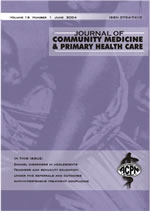
|
Journal of Community Medicine & Primary Health Care
Association of Community Physicians of Nigeria
ISSN: 0794-7410
Vol. 16, No. 1, 2004, pp. 10-15
|
 Bioline Code: pc04003
Bioline Code: pc04003
Full paper language: English
Document type: Research Article
Document available free of charge
|
|
|
Journal of Community Medicine & Primary Health Care, Vol. 16, No. 1, 2004, pp. 10-15
| en |
Reasons and outcome of paediatric referrals from first-level health facilities in Sabongari, Zaria, Northwestern Nigeria
E. O. Musa and C. L. Ejembi
Abstract
Background:
Referral is a crucial component of primary care and when appropriately carried out is believed to result in favourable outcome of illnesses. This study sought to determine the reasons and outcomes of Paediatric (under-five) referrals from first-level health facilities, and the factors influencing the outcomes.
Methods:
A cross-sectional descriptive study was carried out in six sampled public first-level health facilities in Sabon Gari Local Government Area of Kaduna State in the Northwest zone of Nigeria. A total of 106 under-five children referred during the sixteen-week study period from the six sampled health facilities were studied. Structured questionnaires and a two-way referral form were designed and used for data collection and the children followed up to determine the type of care received and its outcome.
Results:
Diarrhoea was the most common reason for referral (34%) followed by convulsion (10.4%), difficulty in breathing (8.5%) and surgery (8.5%). The most important reason for the decision to refer was for better diagnosis and treatment (70.8%). The referral compliance rate was 37.8%. Of those that complied, 31 (83.8%) of them recovered, 6 (16.2%) died and none had a disability (P > 0.05). Of the 61 (62.2%) of the referrals that did not comply, the majority (65.6%) of them were treated by traditional healers while 34.4% were managed at home using home-based remedies. The compliant referrals were found to significantly have more favourable outcomes than the non-compliant cases. Factors that influenced the referral outcomes included compliance, transport difficulty, financial constraints and husband's consent.
Conclusion:
Referral to a higher level of care where there are better facilities for diagnosis and treatment generally improve the chances of a favourable outcome.There is a need for adequate investment in resources at first-level health facilities to make referrals worthwhile and more effective.
Keywords
Child illness, Referral, First-level health facilities, Reasons, Outcome
|
| |
© Copyright 2004 - Journal of Community Medicine & Primary Health Care
|
|
